December 2018
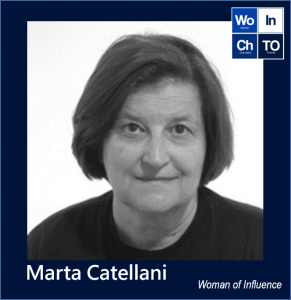
Marta Catellani (? – Present)
Dr. Marta Catellani is a Professor of Chemistry at the University of Parma in Italy. She earned her doctorate degree (Italian Laurea) in chemistry from the same institution in 1971. Since then, her work in developing metal-catalyzed organic reactions has led to the discovery of several multi-step and multi-component reactions centered around palladium. Most prominently, she reported the Catellani Reaction in 1997 describing a cascade reaction catalyzed by palladium and norbornene to replace relatively unreactive C–H bonds with useful functional groups. Out of more than 100 named reactions in organic chemistry, approximately 15 were discovered and developed by female chemists.
November 2018
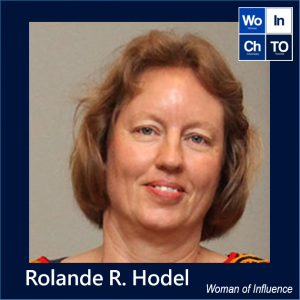
Rolande R. Hodel (? - Present)
Dr. Rolande R. Hodel is the founder and president of AIDSfreeAFRICA, a non-profit organization that is dedicated to empower the people of Cameroon to become self-sufficient in producing, distributing, and conducting quality control of pharmaceutical drugs. Her story is certainly not linear. She overcame many obstacles, such as family expectations to work a trade job, gender discrimination when she wanted to change her studies from psychology to chemistry, and immigration to the United States. Despite these challenges, Hodel received her M.Sc. in Inorganic Chemistry from the University of Kansas and then Ph.D. in Organic Chemistry from the City University of New York, Queens College with Prof. Harry D. Gafney.
Inspired by Brazil’s success story of producing affordable generic HIV/AIDS drugs, Hodel founded AIDSfreeAFRICA in 2005. One of the first projects was to support the development of Diamond Pharmaceuticals, a company founded by three Cameroonian pharmacists with the aim to reduce the cost of medication. The company has focused on packaging bulk generic drugs instead of importing the pre-packaged good which reduces the costs by 10 to 25%. Diamond Pharmaceuticals hopes to move into pharmaceutical formulation which could reduce the overall cost of medication by 25 to 40%.
Hodel is extremely involved with all aspects of AIDSfreeAFRICA, she oversees grant writing, ensures Good Manufacturing Processes, speaks in public, trains volunteers, and consults with other pharmaceutical companies. For her dedication to better the lives of populations in developing countries, she received the 2009 U.S. Astellas Award. She also serves on the board of directors of Chemists Without Borders, and is active at the local, national, and international levels within the American Chemical Society. Eventually, Hodel hopes to initiate other self-sustaining projects in Ghana and Rwanda.
October 2018
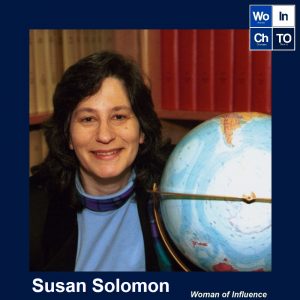
Susan Solomon (1956 – Present)
Susan Solomon is an atmospheric chemist and Ellen Swallow Richards Professor of Atmospheric Chemistry and Climate Science at the Massachusetts Institute of Technology.
Solomon’s interest in science began in her childhood, developed during high school, and flourished throughout her undergraduate years at the Illinois Institute of Technology. In 1977, her interest in chemistry led her to pursue graduate studies in atmospheric chemistry at the University of California, Berkeley. After receiving her PhD in 1981, Solomon began working at the National Oceanic and Atmospheric Administration (NOAA) Earth System Research Laboratory. There, Solomon studied the effects of chlorofluorocarbons (CFCs) on the ozone layer.
She proposed the ozone hole looming over Antarctica was caused by a reaction between ozone molecules and free radicals from CFCs that are present on ice surfaces in high altitude regions like Antarctica. Solomon also theorized that clouds at high altitudes, specifically polar stratospheric clouds, attracted CFCs. The CFCs would then crystallize on the clouds and create the perfect conditions for ozone-depleting reactions to occur, such as the formation of ClO, leading to conversion of ozone to oxygen. To test her theory, Solomon led expeditions in 1986 and 1987 to investigate what exactly was boring a hole through Antarctica’s ozone layer. Indeed, Solomon’s hypothesis was correct: the high altitudes in the Arctic region create conditions that promote ClO formation and depletion of the ozone layer. Solomon’s research contributed to the implementation of the Montreal Protocol in 1987. In 1999, Solomon was awarded the National Medal of Science for her work confirming a link between CFCs, ClO, and ozone layer depletion.
September 2018
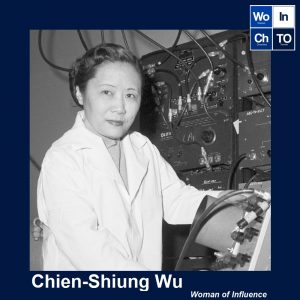
Chien-Shiung Wu (1912 – 1997)
Chien-Shiung Wu was born in the town of Liuhe in China. After studying mathematics and later physics at the National Central University in Nanjing and being strongly involved in student politics on campus, she became a researcher at the Institute of Physics of the Academia Sinica, and later moved to the U.S. to earn her PhD at Berkeley under Ernest Lawrence. She later married physicist Luke Yuan and moved with him to the East Coast, where she worked as faculty at the Smith College in Massachusetts, and later at Princeton University in New Jersey. In 1944, she joined the Manhattan Project’s Substitute Alloy Materials (SAM) Laboratories at Columbia University, working on uranium enrichment. She became a full professor at Columbia University in 1958 and the Michael I. Pupin Professor of Physics in 1973. After the war, she made significant contributions in the field of nuclear physics, notably the Wu experiment, which contradicted the hypothetical law of conservation of parity and served to help establish the Standard Model. She also confirmed Enrico Fermi’s theory of Beta decay. Her colleagues Tsung-Dao Lee and Chen Ning Yang received the Nobel Prize for physics in 1957 for their work on the Wu experiment, but Wu’s own contribution was only honored in 1978, when she was awarded the inaugural Wolf Prize. Later in life, Wu became a vocal critic of gender discrimination, and was quoted as saying, “I wonder whether the tiny atoms and nuclei, or the mathematical symbols, or the DNA molecules have any preference for either masculine or feminine treatment.” She was often nicknamed “Chinese Marie Curie” and “Queen of Nuclear Physics”.
August 2018
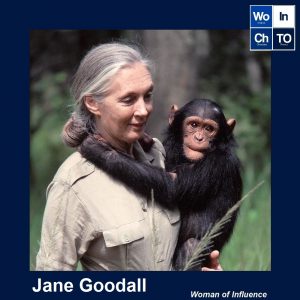
Jane Goodall (1984 – Present)
Jane Goodall is a primatologist, anthropologist, and activist, and is considered the world’s foremost expert on the behavior of wild chimpanzees. In 1965, she received her PhD from Newham College at Cambridge University in ethology. Goodall began her 55-year long study on chimpanzee social and family life in 1960. This study focused on the Kasakela chimpanzee community in Gobme Stream National Park in Tanzania. Her work revealed that chimpanzees have complex social behaviors and have affectionate bonds within families and communities. Goodall’s research at Gombe Stream challenged two long-standing beliefs in the scientific community: that only humans could construct and use tools, and that chimpanzees were vegetarians. She discovered that chimpanzees systematically hunt and eat smaller primates. She also saw aggressive behavior within and between chimpanzee communities, including the 1974-1978 Gombe Chimpanzee War, which was a violent conflict between two chimpanzee communities. Goodall deviated from scientific convention by giving the animals in her study names, rather than numbers. This allowed her to develop close bonds with the chimpanzees, and as a result she became the only human to ever be accepted into chimpanzee society. She has also worked extensively as an activist for animal welfare and conservation issues. Goodall founded the Jane Goodall Institute, the Roots & Shoots programme, and served on the board of the Nonhuman Rights Project.
July 2018
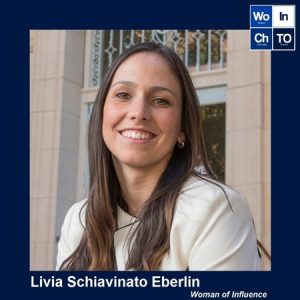
Livia Schiavinato Eberlin (? – Present)
Livia S. Eberlin leads a research group dedicated to developing novel mass spectrometry techniques to detect cancerous tissue. She completed her BSc at the State University of Campinas (UNICAMP) in her hometown of Campinas, São Paulo, Brazil. During her undergraduate degree, she began research in mass spectrometry in the Thomson Laboratory (UNICAMP), and was a visiting student at the Aston Laboratory at Purdue University. She continued to pursue her PhD in Analytical Chemistry under the supervision of Prof. Graham Cooks at Purdue, during which she worked on developing the MassSpec Pen, a handheld mass spectrometry device designed for rapid and non-destructive diagnosis of human cancer tissues. The MassSpec Pen was featured in an episode of Grey’s Anatomy! Following her PhD, Prof. Eberlin continued to use ambient ionization methods as a postdoctoral scholar in Prof. Richard Zare’s lab (Stanford University). Currently as an Assistant Professor at the University of Texas at Austin, her research group aims to progress the interface of chemistry and medicine, and to address important clinical issues using mass spectrometry.
Prof. Eberlin has earned numerous awards, including the L’Oréal USA for Women in Science Fellowship (2014), Marion Milligan Mason Award for Women in the Chemical Sciences (2014), and the Sloan Research Fellowship (2018). In 2015, she was included in the “Forbes’ 30 under 30” list in Science and Healthcare whilst a postdoctoral scholar. Outside of work, her group volunteers together, and she raises three children with her husband.
June 2018
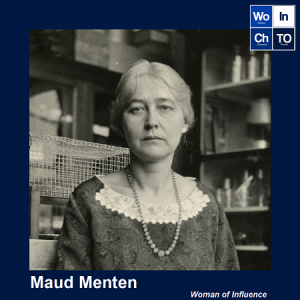
Maud Menten (1879 – 1960)
When we think about reaction kinetics, many of us might recall the Michaelis-Menten equation – perhaps one of the first things we learn about enzyme reactivity in our biochemistry classes. But did you know that the equation is named for Canadian physician Maud Menten? Menten was born in Port Lambton, Ontario and was one of the first Canadian women to receive a medical degree. She attended the University of Toronto where she earned her Bachelor of Arts degree, Masters of Physiology degree, as well her medical degree. Unfortunately, women were not permitted to conduct research in Canada, so she completed her PhD at the University of Chicago in 1916. Her seminal work on enzyme kinetics was published in 1913 with biochemist Leonor Michaelis in Berlin, Germany. The Michaelis-Menten equation, used to determine the reaction rates of enzymes, helped shape modern biochemistry and enzymology. She was also an early pioneer of protein separation by gel electrophoresis and studied human hemoglobin using this method before Linus Pauling! Menten passed away in 1960 at the age of 81 in Leamington, Ontario and was posthumously inducted into the Canadian Medical Hall of Fame in 1998.
May 2018
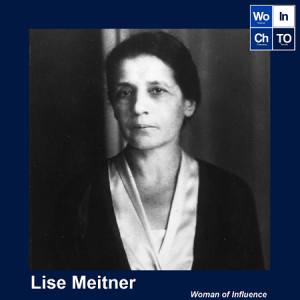
Lise Meitner (1878 – 1968)
Most of us see curium, element 96, and think of the woman it was named after, Marie Curie. But did you know there is another element on the periodic table named after a woman? The synthetic element 109, of which there have been fewer than 10 atoms made, was named after Austrian-Swedish physicist Lise Meitner. Born into a Jewish family in Vienna, Austria in 1878, Lise Meitner was one of eight children of Philip Meitner, who was one of the first Jewish lawyers in Austria. In 1901, she began her studies in physics under Ludwig Boltzmann (of the Boltzmann distribution or the Boltzmann constant in statistical mechanics) at the University of Vienna, and in 1906 she became the second woman to receive a doctoral degree in physics at the university. After graduation, she moved to Berlin where she attended lectures from famous physicist Max Planck and joined German chemist Otto Hahn, who she worked with for 30 years. Meitner’s list of accomplishments is quite impressive, including her discovery of element 91 protactinium in 1918 and the Auger effect in 1923. Her claim to fame however lies in the discovery of nuclear fission – the splitting of an atomic nucleus into smaller parts. This finding, however, was made in 1939, one year after Meitner was forced to flee Germany due to the Nazi takeover. As a result of her move, her meetings with co-worker Hahn were done in secret, leading to Hahn taking most of the credit for the discovery. He was awarded the Nobel Prize for Chemistry in 1944, with Lise Meitner’s contribution largely ignored until 1966 when she was awarded the Enrico Fermi Award – a prestigious award for excellence in research surrounding technology and energy science that benefits mankind. After living a fulfilling life, Lise Meitner passed away in her sleep in October 1968 at the age of 89.
April 2018
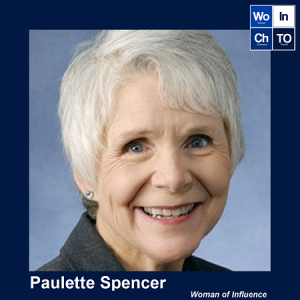
Paulette Spencer (? – Present)
Dr. Paulette Spencer is engaged in the creation of new biomaterials specifically for improving the health of our teeth. A well-rounded researcher, her five (!) degrees from the University of Missouri-Kansas City, University of Minnesota, and Rensselaer Polytechnic Institute include an interdisciplinary PhD in Oral Biology and Physics. Spencer is a pioneer in the development of non‐destructive techniques for in situ characterization of structure/property relationships at material/tissue interfaces, especially the use of Raman spectroscopy to image biological samples. She was integral to propagating the idea of interfacial degradation in dentistry – the weakening of materials at interfaces – which also happens to be one of the most common reasons for the failure of dental fillings. Many restorative dental procedures (70%) are simply to replace previous failed materials. Spencer desires to develop new multi-functional materials to repair, reconstruct and regenerate oral and craniofacial tissues. She has received numerous honours and awards, including the Fulbright U.S. Scholar Award to Brazil for “Driving Biomaterials Discovery”. She is the current director of the Bioengineering Research Center at the University of Kansas.
March 2018
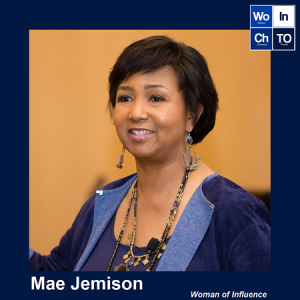
Mae Jemison (1956 – Present)
Dr. Mae Jemison is an American chemical engineer, NASA astronaut, physician, and professor. She traveled aboard the Space Shuttle Endeavour in 1992, becoming the first African American woman to travel in space. Dr. Jemison was born in Alabama in 1956, and grew up in Chicago. She graduated from Morgan Park High School at 16 years of age, then went on to attend Stanford University where she earned a B.S. in Chemical Engineering. In 1981, she earned a Doctor of Medicine degree from Cornell University. During her studies at Cornell, she traveled to Cuba, Kenya and Thailand to provide medical care. After graduation, Dr. Jemison served in the Peace Corps as a Medical Officer from 1983 to 1985 where she was responsible for the health of volunteers serving in Liberia and Sierra Leone. Upon returning to the U.S., Dr. Jemison worked with Cigna Health Plans of California as a general practitioner. In 1987, she became the first African-American woman to be admitted into NASA’s astronaut training program. In 1992, she flew into space aboard the Endeavour on mission STS47, becoming the first African-American woman in space. After leaving NASA in 1993, she assumed teaching positions at Dartmouth University, followed by Cornell University. Dr. Jemison is an advocate of science education in schools that encourage minority students to pursue STEM careers. Her entrepreneurial activities include founding the Jemison Group to develop technology for daily life, and the creation of BioSentient Corp to develop portable technology to monitor the nervous system. She has won many awards including the Kilby Science Award in 1993 and the Intrepid Award by the National Organization for Girls in 2003.
February 2018
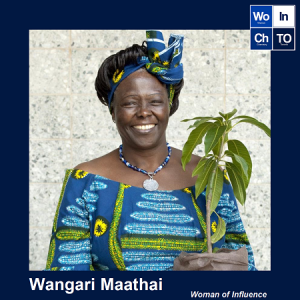
Wangari Maathai (1940 – 2011)
Wangari Maathai (born April 1, 1940) was an ecologist and environmental activist from Kenya. She studied Biology at Mount St. Scholastica College in the US and received her master’s degree in Biology from the University of Pittsburgh in 1966. She studied at the University of Giessen and the University of Munich in Germany and received her PhD in Veterinary Anatomy from the University of Giessen in 1971, becoming the first East African woman to receive a PhD. She worked as a lecturer in anatomy at the University of Nairobi and was the first woman there to become an associate professor. She was active in environmental nongovernmental organizations and the National Council of Women of Kenya (NCWK). She ran for a parliamentary seat in 1982, but after a political battle she was barred from running. She then started the Green Belt Movement in partnership with the NCWK and the Norwegian Forestry Society. This organization empowers women in rural areas to plant trees to support environmentalism, build community, and provide tangible benefits to people’s lives. Since its inception, over 30,000 women have been trained by the organization. In the proceeding decades Maathai was involved in much environmental and political activism in Kenya. She was elected to parliament in 2002 and was appointed assistant minister of the Ministry for Environment and Natural Resources. She received the 2004 Nobel Peace Prize for her “contributions to sustainable development, democracy, and peace,” making her the first African woman and first environmentalist to win the prize. Wangari Maathai died in 2011 of ovarian cancer.
January 2018
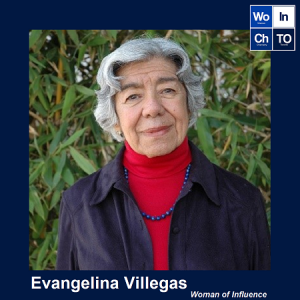
Evangelina Villegas (1924-2017)
Dr. Evangelina Villegas was a Mexican biochemist whose research led to the development of quality protein maize. She and her colleague, Dr. Surinder Vasal, received the 2000 World Food Prize for the impact of their work on improving productivity and nutrition in malnourished and poverty-stricken areas. Born in 1924 in Mexico City, Villegas earned a Bachelor of Science degree in chemistry and biology at the National Polytechnic Institute. She began her career as a research chemist in 1950 at Mexico’s National Institute of Nutrition and at the Special Studies Office, that would later become the International Maize and Wheat Improvement Center (CIMMYT). She left for a brief period to earn a Master of Science degree in cereal technology from Kansas State University and a doctoral degree in cereal chemistry and breeding from North Dakota State University, in 1967. While in charge of the lab investigating protein quality, she partnered with Surinder Vasal, a CIMMYT maize breeder, to develop a variety of maize with higher levels of lysine and tryptophan, two key amino acids. Their many years of research culminated in the creation of quality protein maize, which featured enhanced levels of both amino acids, while maintaining the texture and flavour of conventional maize. Quality protein maize has consistently shown to be particularly effective in improving the nutritional status of young children. Villegas was the first woman ever to receive the World Food Prize and was named “Woman of the year” in Mexico in 2000 for her accomplishments. She passed away in April of 2017.
